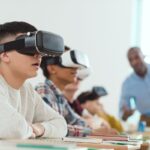Education is a cornerstone of society, shaping the minds of future generations. However, the approach to education has evolved significantly over the years, particularly when comparing the Baby Boomer generation to Millennials. Let’s get into the unique characteristics of each generation’s approach to education.
Table of Contents
1. Traditional vs. Technological Learning

Baby Boomers grew up in an era where education was primarily delivered in a traditional classroom setting. Learning was often teacher-centered, with students passively receiving information.
On the other hand, Millennials have embraced technology in education. They are comfortable with online learning platforms, digital textbooks, and using technology as a tool for collaborative learning. This shift towards technology has made learning more interactive and student-centered.
2. Rote Memorization vs. Critical Thinking

For Boomers, education often involved rote memorization. Students were expected to absorb and regurgitate information with less emphasis on understanding the underlying concepts.
Millennials, however, have been encouraged to develop critical thinking skills. They are taught to question, analyze, and understand the material rather than just memorize it. This approach fosters a deeper understanding and application of knowledge.
3. Fixed Mindset vs. Growth Mindset

Many Boomers were brought up with a fixed mindset, believing that intelligence and abilities are static. Success was often attributed to inherent talent rather than effort.
Millennials, however, have been introduced to the concept of a growth mindset. They are taught that intelligence can be developed, and that effort and perseverance are key to success. This mindset encourages continuous learning and resilience.
4. Standardized Testing vs. Holistic Assessment

Boomers’ academic performance was often measured through standardized tests. These tests focused on specific knowledge areas, with less emphasis on creativity or problem-solving skills.
Millennials, however, are more likely to be assessed through a variety of methods, including projects, presentations, and group work. This holistic approach recognizes a broader range of skills and abilities.
5. Competitive vs. Collaborative Learning

Boomers were often encouraged to compete with their peers for top grades and recognition. This competitive environment could drive achievement, but it could also create pressure and stress.
Millennials, in contrast, are often encouraged to collaborate with their peers. They work on group projects, share ideas, and learn from each other. This collaborative approach fosters teamwork and communication skills.
6. Teacher Authority vs. Teacher Facilitator

In the Boomer era, teachers were considered the ultimate authority in the classroom. They were the primary source of knowledge, and students were expected to respect and obey them.
For Millennials, teachers often act more as facilitators than authoritative figures. They guide students in their learning, encourage them to ask questions and help them discover answers for themselves.
7. Single-Career Focus vs. Diverse Career Exploration

Boomers were often encouraged to choose a career path early and stick to it. This approach provided stability but could limit exploration and personal growth.
Millennials, however, are encouraged to explore diverse career options. They are more likely to switch careers, seek out diverse experiences, and prioritize personal fulfillment over job stability.
8. Formal vs. Informal Learning Environments

Boomer classrooms were often formal and structured, with strict rules and expectations.
Millennial classrooms, however, tend to be more informal and flexible. They often feature comfortable seating, interactive learning stations, and a more relaxed atmosphere.
9. Textbook Learning vs. Real-World Learning

Boomers often learned from textbooks and lectures, with less opportunity for real-world application.
Millennials, however, are often exposed to real-world learning opportunities, such as internships, service learning, and experiential learning projects.
10. Education as a Duty vs. Education as a Right

For many Boomers, education was seen as a duty and a privilege, something to be respected and not taken for granted.
For Millennials, education is often seen as a right. They advocate for equal access to quality education for all, regardless of socioeconomic status.
To wrap this up, both Boomers and Millennials value education; their approaches reflect the societal and technological changes of their times. Understanding these differences can help us create a more inclusive and effective education system that caters to the needs of all learners.








